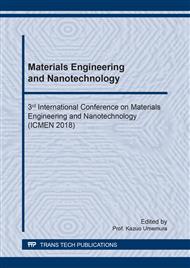p.136
p.142
p.151
p.159
p.164
p.171
p.178
p.187
p.192
Microstructure and Oxidization of Mo Alloys by Spark Plasma Sintering
Abstract:
In the scope of refractory material processed by spark plasma sintering development for structural applications in the core of future combustion chamber, Mo-TiC alloys and Mo-TiC-Cr alloys were sintered at 1700°C with a pressure of 30 MPa. Powders of Mo, TiC and Cr were prepared by planetary ball mill in an argon atmosphere. In this dissertation, the structure, element and phase composition of alloys were investigated. The Mo-TiC alloys showed obvious intergranular brittle fracture. The fracture mode of Mo-TiC-Cr alloys, however, was changed to mixed intergranular and transgranular fracture. The obtained results demonstrated that, compared with the peaks of Mo and Mo2C from Mo-TiC, the peaks of Mo and Mo2C from Mo-TiC-Cr were deflected to the right, due to the addition of chromium forming a solid solution. The results of isothermal oxidation tests at 1200°C in air revealed that the chromium compound on the surface of the oxide layer increases and the pores decreases with the increase of oxidation time for Mo-TiC-Cr alloys. The pores of surface of the Mo-TiC alloys were less and smaller than the Mo-TiC-Cr.
Info:
Periodical:
Pages:
164-170
Citation:
Online since:
October 2018
Authors:
Keywords:
Price:
Сopyright:
© 2018 Trans Tech Publications Ltd. All Rights Reserved
Share:
Citation:


